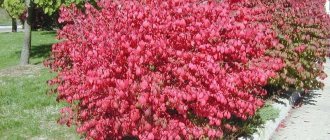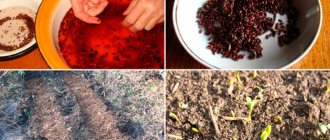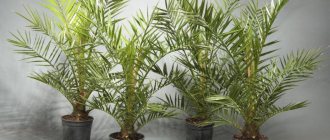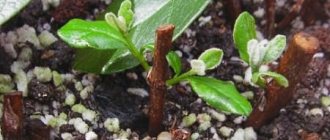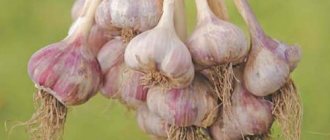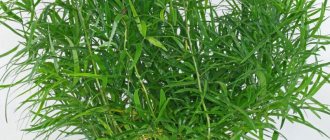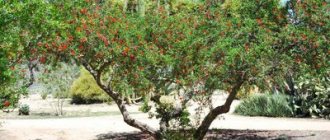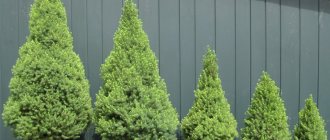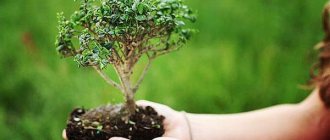Unabi, known under the names jujube, chilon, jujube, Chinese date, belongs to the genus Krushinaceae and unites 50 species. The plant was cultivated in ancient times and is widespread in China, Japan, Australia, and Mediterranean countries. In our country, on the Black Sea coast of the Caucasus, amateur gardeners have long grown small-fruited varieties of Chinese dates. Large-fruited forms were brought to Russia only in the middle of the last century. The first collection plantings of jujube in the Nikitsky Botanical Garden were planted in 1953. Since the late 80s. breeders began to study the peculiarities of cultivating this crop in different climatic zones, as a result, new varieties were created that were adapted to unfavorable environmental factors.
Chinese date - a plant with medicinal fruits
Unabi is a large shrub or small tree up to eight meters high, with a sparse spreading crown and leaves that fall off in the winter. Wild plants have large, sharp spines on their branches; many cultivated large-fruited forms do not have these spines, which is their clear advantage over wild plants. The fruits of wild and cultivated forms of jujube differ mainly in size: from 5 grams for small-fruited wild specimens to 30–40 grams for the best large-fruited varieties. There is also some difference in the taste of the fruits, and many people prefer wild unabi. In terms of medical properties, the fruits of wild and cultivated forms of unabi are considered to be equivalent.
Unabi, or common jujube, is also known as jujube, jujuba, jujube, chilon, red date, Chinese date.
Chinese date on video
Unabi fruit is widely used in traditional Chinese medicine. In the middle of the last century, experiments were conducted in sanatoriums in Crimea that showed that regular consumption of fresh jujube fruits helps lower blood pressure. Since then, active cultivation of this oriental fruit crop began in Crimea and the southern regions of Ukraine and Russia with similar climates.
It should be noted that unabi fruits, like any other medicinal plant, are not at all a miraculous magic cure for all ills. For example, my neighbor in the country, who lived in Crimea for many years, is very skeptical about this miracle berry, because she personally has not been able to solve the problem of high blood pressure with the help of unabi over many years.
In the wild, unabi grows in Iran, Afghanistan, Central Asia and Western China. This part of Central Asia is characterized by an arid continental climate with very hot, long summers and short but relatively frosty winters. In its natural growth area, unabi has been cultivated since time immemorial, and many varieties have been created, some of which have begun to be grown in Europe and America. Good conditions for jujube culture are found in North Africa, Southern Europe, Western Asia, the arid regions of India, as well as in the dry subtropics of some US states, including Texas and California.
Due to the similarity of the dried fruit to dates, unabi is also called the Chinese date.
The traditional way of processing unabi fruits for long-term storage is drying. Dried unabi fruits are very similar in appearance to dates, hence the names “Chinese date” and “red date” - based on the color of some popular varieties.
Unabi begins its growing season very late, much later than most trees and shrubs. Because of this late awakening, many novice gardeners unknowingly uprooted completely viable plants, mistakenly deciding that the bushes had died over the winter.
On my site, the unabi bushes began to barely open their first leaves only in mid-May, a couple of weeks later than all other plants. Of course, against the background of the riot of spring greenery, such slow-witted people look very suspicious. If the bush is large, you can easily dispel doubts by cutting a branch and looking at the cut: dead wood becomes dry, black or brown. It’s better not to cut a small bush in vain, just wait until at least mid-June.
In any case, there is no need to rush to uproot: even if the above-ground part is frozen, there is hope for the appearance of root shoots.
Small yellow unabi flowers are very honey-bearing
Jujube blooms very late, only in June, after the complete end of possible frosts. Its small yellow flowers are very honey-bearing and attract many bees and other pollinating insects. To obtain good harvests, unabi needs cross-pollination, so you need to plant plants of several varieties or several different seedlings nearby. Self-pollination produces only a few fruits, most of which soon fall off long before ripening begins. Fully ripened fruits become soft, sweet and juicy, red or brown in color.
The moment of best taste of jujube fruits depends very much on the variety and on personal preferences: some people prefer those that are still dense, others prefer those that are overripe and have already begun to wilt a little.
When ripe, unabi fruits become red or brown in color.
In favorable conditions, jujube trees are very durable. There are known cases of abundant and regular fruiting of specimens that have reached a hundred years of age. Under normal weather conditions, good fruit harvests occur annually. Unabi is a fast-growing crop; with good care, the first flowers and fruits can appear within two to three years after planting the seedling. As the bushes grow, the yields increase. From a large mature tree in good conditions you can get up to 50 kilograms of fruit. They ripen late, usually in October; for the earliest varieties, at the end of September. The period of fruit ripening on each plant can last up to a month, as a result of an equally long extended flowering. The collected fruits are poorly stored fresh, even in the refrigerator for no more than a week, and do not withstand long-distance transportation. In addition to traditional drying, they are also suitable for home canning; they make excellent compotes, jams, and preserves.
Unabi fruit makes delicious jam
Features of fruiting and preparation for winter
Fruiting of the crop begins 2 years after planting. The plant is characterized by sweet or sour fruits. They combine a large number of unique components.
Dates have excellent yields
Dates contain trace elements, ascorbic acid, and ingredients with P-vitamin activity. Thanks to the use of this product, it is possible to normalize blood pressure and make blood vessels more elastic.
A plant's resistance to frost depends on its variety. In the first years, all types of crops need to be covered. To do this, you need to hill up the plantings and cover them with non-woven material. It is very problematic to cover older crops.
Important! Slight freezing of shoots usually does not affect yield parameters. In spring, it is necessary to cut off all affected branches.
Types and varieties of unabi, its relatives and doubles
Of all the types of jujube, the most famous is the common jujube, or Chinese unabi (Ziziphus jujuba). In tropical and subtropical countries, two more related species of jujube are cultivated to produce edible fruits:
- lotus tree (Ziziphus lotus);
- Mauritanian jujube (Ziziphus mauritiana).
Differences between jujube species (table)
| Russian name | Latin name | Origin | Leaves | Fruit |
| Common jujube (unabi) | Ziziphus jujuba | central Asia | Ovate-pointed, fall off in winter | Oval, red or brown |
| lotus tree | Ziziphus lotus | Mediterranean | Round, fall off in winter | Round, yellow |
| Jujube Moorish | Ziziphus mauritiana | North Africa | Round-oval, evergreen | Round, yellow to brown |
All these three types of jujube are often referred to in foreign literature under the general name jujube, which sometimes creates some confusion.
Of all the types of jujube, only common jujube (also known as Chinese or unabi) is suitable for cultivation in Russia and Ukraine, as it is the most winter-hardy of them.
Also, unabi are often confused with two more plants that have no botanical relationship with jujubes: jojoba (Simmondsia chinensis) and oriental elk.
- The confusion with jojoba is purely linguistic (unabi - jujube, hojoba - jojoba), which regularly arises in foreign and translated articles, catalogs of planting material, and especially in advertising of various preparations for cosmetic and pharmacological purposes. Jojoba is an evergreen plant that cannot withstand freezing temperatures.
- Confusion with the oriental sucker arises due to the striking external similarity of its fruits to the fruits of unabi. Elf is much more winter-hardy compared to unabi; its wild form (angustifolia elk) grows successfully without any shelter in the Moscow region and in the Middle Volga region.
Even in very reputable printed publications, I came across published letters from readers who successfully grew oleaster from the seeds of oleaster fruits, while being in full confidence that they were growing unabi. But the pharmacological properties of the fruits are still very, very different.
Unabi, jida and jojoba: their differences (table)
| Name | Origin | Leaves | Flowers | Fruit | Seeds in fruits |
| Eastern elk (dzhida, pshat) Elaeagnus orientalis | Eastern Europe, Caucasus, Central Asia, Siberia | Silvery-green, long and narrow, arranged alternately, falling off in winter | Small, yellow, bell-shaped with 4 petals, bisexual, pollinated by insects | Oval, reddish-brown, mealy-sweet, used as food | Uniformly narrow, with pronounced parallel longitudinal stripes |
| Common jujube (jujube, jujuba, yuyuba, unabi, Chinese date, chilon) Ziziphus jujuba | Central Asia, Western China | Bright green, shiny, ovoid-pointed, arranged alternately, fall off in winter | Small, yellow, wide open with 5 petals, bisexual, insect pollinated | Oval, red or brown, juicy, sweet, used as food | Wide, with random, weakly expressed grooves and a clearly visible pointed elongated tip |
| Chinese Simmondsia (jojoba, hojoba, jojoba) Simmondsia chinensis | California | Silvery-green, oval-elongated, arranged in pairs, evergreen | Small, yellow, wind-pollinated; male and female on different plants | Dry boxes with a clearly visible cup at the base | The seeds are similar to nuts; seed oil is used in pharmaceuticals and cosmetology |
Unabi, his relatives and doubles (photo gallery)
Jujube moorish is an evergreen fruit plant from North Africa.
The lotus tree is a fruit crop from the Mediterranean, a relative of the unabi
The most famous of the jujubes is unabi, or Chinese date. The fruits of the oriental oleaster (jida) are surprisingly similar in shape, size and color to the fruits of unabi
Oriental lox blooms with yellow bell-shaped flowers with 4 petals
Wide-open flat unabi flowers always have 5 petals
The seeds of the oleaster fruit are easily identified by their characteristic parallel longitudinal stripes.
Unabi seeds have an elongated, sharp nose and faintly noticeable random grooves
Hojoba (Simmondsia chinensis) has dry fruit-boxes with large sepals
Valuable oil for pharmaceuticals and cosmetology is extracted from jojoba seeds and nuts.
Of the large-fruited varieties of unabi, Koktebel and Ta-yan-zao are the most widespread in Russia and Ukraine.
- Koktebel is a relatively new variety bred by the Nikitsky Botanical Garden in Crimea. The fruits weigh 30–35 grams and ripen late. The variety is included in the State Register of the Russian Federation.
- Ta-yang-zao is a very old variety of Chinese selection, brought from China to the USA at the beginning of the last century, and from there to Russia. It still remains one of the best varieties. Early ripening variety, fruit weight from 18 to 45 grams.
On some websites of private nurseries, large-fruited unabi varieties Si-qing, Acorn and Dessertny are also briefly mentioned, but these varieties are not in the State Register or in serious literature.
Large-fruited unabi varieties (photo gallery)
Unabi Koktebel
Unabi Ta-yan-zao
Unabi Si-qing
Unabi Dessert Unabi Acorn
Preparing date pits for planting
Before you can sprout a date from a seed, you need to get it somewhere. It’s not difficult - dates are bought, but not roasted, eaten, and the remaining grains can be immersed in the ground.
Date pit
The correct dates from which to take the pit are fresh fruit, dates brought from other countries, dried fruit.
Additional Information! The best time to plant a plant from a seed is from February to March.
Selection and preparation of planting material
The appearance of a palm tree is possible only from those seeds that have not been subjected to heat treatment.
A step-by-step algorithm for seed procurement is described below.
Step 1. The seeds are removed from the fruit and washed under running water. If this is not done, the remaining particles from the fruit can trigger the process of rotting in the ground. Washed seeds should be left for at least 24 hours.
Step 2. Because the seeds of the plant are very hard, it is difficult for them to germinate. To speed up this stage, the following methods will help:
- scratch the surface of the bone with sandpaper so that moisture penetrates into it more easily;
- make several cuts so that the shell splits faster;
- scald with very hot water.
The best way to speed up the germination process is to soak the seed in cotton wool. You need to put cotton wool soaked with water in a plate, put a seed in it, and cover it with another piece of wet cotton wool.
For reference! Instead of cotton wool, you can use hydrogel, sawdust or gauze.
Step 3. Place the container with the bone in cotton wool in a warm place, for example, on a radiator.
As the cotton dries, it should be moistened with water. As soon as the seed swells, it can be planted in the ground.
To increase the chances of having a date tree, you need to prepare some seeds. Some of them will not be able to sprout.
Step 4. The seeds are placed in the ground to a depth of 1 - 2 cm. All seeds can be placed in one container, which makes it easier to care for. Before the seedlings appear, the soil should be watered frequently, but not flooded.
Attention! The seed is placed in the soil in a vertical position. In containers with seeds, you need to make small holes at the bottom so that the water does not stagnate.
In containers with seeds, you need to make small holes at the bottom so that the water does not stagnate.
The soil is nutritious soil; it is recommended to add sawdust or sand to it. The room temperature should be between 24 °C and 26 °C. The lower the temperature, the longer it will take for the swelling to appear. Sometimes this takes up to 10-12 months.
Watering should be done at such intervals that the soil is moist but not wet. On average, it takes from 1 to 3 months for seedlings to emerge. It all depends on the quality of the planting material and compliance with all recommendations.
As soon as the green stem that has broken through reaches a height of 10 cm, you can transplant it into another flowerpot.
Soil selection
Before you grow a date from a seed, you need to select the soil. Purchased land intended for palm trees is best suited. You can make soil suitable for dates yourself:
- 2 parts clay-turf soil;
- 2 parts of humus-leaf soil;
- 1 part peat;
- 1 part rotted manure;
- 1 part sand.
Attention! There should be drainage at the bottom of the pot. Its function can be performed by charcoal, expanded clay, small fraction pebbles
It prevents stagnation of water in the ground, which is detrimental to the palm tree.
Planting a sprouted seedling
There is nothing complicated about transplanting a seedling. But you need to take into account that the date palm treats the procedure of changing places very poorly. Quite often, quite actively growing seedlings died after being transplanted into another flowerpot. To avoid this, the seedling is placed in a new container with a lump of earth in which its roots are located. This way the palm tree will gain a foothold faster without experiencing severe stress.
In winter and spring, the palm tree will develop slowly. Watering should be reduced to a minimum, only to maintain soil moisture. The plant does not need fertilizing; it will not speed up its development.
The first few years after transplanting the seedlings, the palm tree looks like tough grass. In the 3rd year, the leaves expand, their plates become solid.
Future leaf
A real, full-fledged leaf will appear on the plant approximately 4 years after planting. From this moment on, in order for the palm tree to actively develop, it must be looked after properly.
Features of planting jujube
To plant unabi, you need to choose the most sunny places. This plant is very light-loving, with the slightest shading it grows poorly and bears almost no fruit. Jujube is very drought-resistant and heat-resistant, and can withstand 40-degree heat perfectly. At temperatures below +15°C, shoot growth practically stops and flowering is delayed.
Unabi does not tolerate heavy clay soils, excessive acidity and close groundwater. But this unpretentious plant grows well on poor soils and dry rocky slopes, and can be used to secure them.
Unabi grows normally and bears fruit only in full sunlight
Unabi feels normal in open ground south of the Kyiv-Kharkov-Volgograd line. In more northern regions, its cultivation becomes very problematic and requires special tricks.
The best time to plant jujube is early spring (in the south it is late March - early April). In regions with very mild winters, it is permissible to plant in early autumn (in the south - no later than early October). When planting, the distance between seedlings should be at least 4 meters at the latitude of Kyiv, where unabi grows as a bush and regularly freezes. In the subtropical zone, where conditions are more favorable and unabi grows as a tree, it is preferable to leave 5 or even 6 meters between plants.
In favorable conditions of a subtropical climate, unabi grows into a small tree and lives for more than a hundred years.
When choosing seedlings, it is important to ensure that their roots and branches are alive, not dry or rotten. It is best to purchase plants grown in your region. Planting material brought from more southern regions has low winter hardiness.
Step by step planting process:
- Dig a hole about half a meter deep and wide.
- Place a mound of earth mixed with a bucket of well-rotted compost at the bottom of the hole.
- Place the seedling on the mound, carefully straightening the roots. When planting, unabi does not require special depth; the root collar of the seedling should be approximately at the level of the soil surface.
- Carefully fill the hole with earth.
- Carefully water each seedling with a bucket of water from a watering can with a nozzle, without washing out the soil.
Fresh manure and mineral fertilizers are not used when planting, so as not to burn the roots.
Collection and preparation of fruits
- Dates begin to bear fruit after 3-4 years of growth in open ground.
- Fruit ripening occurs closer to mid-autumn. Brown, shiny, small fruits have a sweet taste and dense, fleshy pulp with two seeds.
- The tree blooms for a long time, so the ripening of the fruits does not occur evenly.
- Fruits taken from the tree while unripe are used raw or processed.
- The fruits remaining on the tree until late autumn ripen completely and gain sweetness.
- For harvesting, special combs are used, which comb the date fruits onto the underlying film. Then they are separated from the twigs and leaves.
- Ripe dates are dried, dried, and made into jam and compotes.
Caring for jujube for the south of Russia and Ukraine
Unabi tolerates heat and drought well and can grow without watering even in the dry subtropics of Transcaucasia. But with irrigation, fruit yields will be higher, and the growth and development of young plants will be faster. In the hot and dry climate of Crimea, the southern regions of Russia and southern Ukraine, it is enough to water once a month, with each watering wetting the soil to a depth of at least 80 centimeters. In the complete absence of watering, the roots lie deeper, up to two meters or more.
In arid regions, unabi yield will be higher with irrigation
Plants in the first year of planting are watered more often; in extreme heat and drought - 2 buckets of water per bush weekly.
In a more humid climate (Western Ukraine, part of the Krasnodar region of Russia), the watering rate for young plants is halved, and adult plants do not need watering at all, except in cases of extreme drought.
Jujube grows very slowly, and at a young age it can suffer greatly from weeds, especially perennial rhizomatous ones. To facilitate maintenance and retain moisture, the soil can be mulched with any organic matter (straw, sawdust, wood chips) or special agrofibre.
Mulching retains soil moisture and prevents weed growth
Every spring, fertilizers are applied to the unabi plantation at the rate of each square meter:
- 2–3 kilograms of humus;
- 18–20 grams of superphosphate;
- 8–10 grams of potassium salt;
- 12–16 grams of ammonium nitrate.
Fertilizers are evenly scattered over the entire area under the plants and shallowly embedded in the soil.
Planting dates and scheme
Planting is carried out at the beginning or end of the season, when the plant is dormant.
Planting in spring
The best time for planting seedlings with an open root system is spring: late March - April, before the start of the growing season. By this time, stable heat should have established: the air warms up to +12–14 degrees during the day, and the night temperature does not drop to negative values.
If you rush into spring planting, when the ground is still frozen and cannot be compacted, voids will form near the roots. In these places, the roots can rot without contact with the soil, which will gradually lead to the death of the tree.
Plants planted correctly in the spring will take root over the course of the season, begin to grow a root system, and shoots will begin to grow rapidly. However, when planting in spring, it is necessary to regularly water fragile trees so that they do not die from drought.
Autumn planting
You can plant a tree in the fall, from September to the end of October. The main thing is to carry out planting work 2 weeks before the first frost. If you are late with planting, the plants may not have time to take root before the onset of cold weather.
After autumn planting, it is necessary to hill up the trees; you can also cover them with agrofibre. Such preparation for winter will not be required in the future - unabi tolerates significant drops in temperature well. And if it is damaged by frost, thanks to its high regenerative ability it is restored very quickly. Seedlings are unplanted after the snow melts in cloudy weather in March - April
Container plants are planted all season, even in summer. But not on a hot afternoon, but in the evening or in cloudy weather, to reduce the risk of sunburn of the buds and foliage. Since they are planted using the method of transshipment together with a lump of earth, the root system is not injured during transplantation, the plants quickly and painlessly take root in a new place
Wintering of unabi
In its natural growth zone in Central Asia, jujube easily withstands short-term frosts down to -25..-30°C. Unabi also has fairly high frost resistance in the subtropical zone of Crimea and Transcaucasia, where the hot, long summer is enough for it to ripen the shoots. When moving north, where summers are shorter and summer temperatures are lower, jujube does not have enough summer heat for full development, and its winter hardiness sharply decreases. Even in Kyiv, regular freezing of plants is already observed; in warm winters, only the tops of young branches suffer; in more severe frosts, the bushes freeze to the root collar, but are restored in subsequent years. In regions with relatively mild winters and stable snow cover, it is sometimes possible to preserve plants by bending them to the ground with the onset of the first autumn frosts to overwinter under the snow. Bent plants must be firmly secured with hooks or pressed down with boards. There is no need to wrap it tightly - unabi does not tolerate excessive dampness, and during a long thaw, overly wrapped bushes risk dying from damping off.
Where to place it?
For full development, jujube needs a lot of light. The tree practically does not grow in the shade, and one cannot count on a harvest. Even if unabi blooms in low light conditions, fruits will not set. Therefore, you should choose the sunniest area to plant a tree. At the same time, it must be reliably protected from cold winds and drafts.
Southern and southwestern slopes are optimally suited for growing jujube. It is better to plant it closer to their top or at the base. A good solution would be to place the Chinese date on flat areas near buildings that will shelter it from cold air currents. But the lowlands are completely unsuitable for planting it.
Soil quality is the most important condition for uniform growth and fruiting of unabi. The culture prefers moderately moist loamy soils, fertile, but without an excess of nutrients. In poor and dry land, jujube will bring a meager harvest. If you overdo it with fertilizers, the tree will be completely covered with green leaves, and few fruits will be produced on it.
How to grow unabi in central Russia
Amateur gardeners from the Moscow region and regions close in climate often try to plant unabi, but after several years of existence, these plants usually die in the coming harsh winter. The big problem here is not only low winter temperatures, but also a significant lack of summer heat, which does not allow plants to properly prepare for winter.
Recent Entries
Lilac perennials that are beautiful, compact and do not crowd out other plants Why when buying seedlings you should not take the sellers’ word for it and how to determine the age of the plant using 3 signs Tomato seedlings have turned purple or whitish: why the color has changed and how to save the plants
On my site in the Middle Volga region, three unabi seedlings brought from the south successfully survived the first and second winter. After the third winter, only one bush woke up. The next winter destroyed him too.
One reliable solution to this problem is to plant unabi in an unheated greenhouse attached to the south wall of a heated house. Moreover, for successful wintering of jujube, it is important not only the presence of glazing (an unheated glass greenhouse “in an open field” will not be enough in severe frosts), but also the presence of a warm wall of the house, which is both a source of additional heat and reliable protection from cold northern winds.
Planting in a greenhouse attached to the southern wall of the house will reliably protect unabi from winter frosts
Another possible solution to the wintering problem is the so-called trench culture. This very effective method was invented and successfully tested in Soviet times, and was soon forgotten due to its increased labor intensity. The essence of the method is as follows:
- To plant plants, a permanent trench is dug 70–100 centimeters deep and about one and a half meters wide.
- The walls of the trench are concreted or lined with bricks.
- Planting holes are dug in the bottom of the trench, filled with fertile soil, and seedlings are planted.
- In summer, plants develop in an open trench, as in normal open ground conditions.
- In late autumn, after the end of leaf fall and the final establishment of slightly negative temperatures, the trench is completely covered with boards or slate, and then with plastic film. You can additionally insulate the top with a layer of earth or coniferous spruce branches.
- After a snowfall, the covered trench is covered with a layer of snow taken from areas free of plants (roads, paths, parking areas).
- In the event of prolonged winter warming to above-zero temperatures, the trench should be slightly opened at the ends for ventilation in order to protect the plants from the threat of damping out.
- In the spring, after the snow melts, the permanent cover is removed and the trench is covered with plastic film to protect against return frosts.
- After the end of the frost period, the polyethylene is removed, and all summer the plants grow in an open trench until late autumn.
Trench culture is a reliable, but very labor-intensive way to protect jujube from winter frosts
Beneficial properties of jujube and use in medicine
The usefulness of this plant has been appreciated for a long time. Some gardeners call the tree a pectoral date.
This name is due to the fact that the fruits are used to treat heart and lung diseases. Some sanatoriums use the fruit to treat hypertension. The plant is rich in useful substances such as:
- potassium;
- magnesium.
As a result of using dates, it is possible to achieve a positive result in the treatment of the specified range of diseases. The berry has a beneficial effect on the heart muscles.
It is recommended to use the plant in small quantities. To relieve headaches, it is recommended to take two hundred grams of jujube every day for a three-month period. You can use berries to lower cholesterol levels.
Gardeners are often unaware that dates have beneficial properties. The berry is used in folk medicine. Residents of China use parts of the tree to treat various diseases. Different effects are inherent in fruits, bark, seeds and leaves.
The bark is used to treat diarrhea. It has strengthening effects. To prepare the product, use 10 grams of berries. It is poured with boiling water and kept in a water bath for an hour. The decoction is taken before meals. You need to drink two spoons a day.
The seeds of the plant have sedatives. Can help with stress and depression. These remedies are used to calm the human nervous system. The beneficial properties of the seeds are that they have a beneficial effect on the digestive system.
You need to take 100 grams of seeds and pour half a liter of boiling water. Cook for 10 minutes and add 200 gr. alcohol The mixture is infused for eight hours. Take a spoonful for neurasthenic type diseases, insomnia. Reception occurs three times a day.
The fruits are used to treat jaundice and chronic constipation. If a person suffers from hypertension, he needs to eat fruits every day. Eat 20 berries three times a day. The course of treatment is three months. If the problem is cough, weakness or diarrhea, you need to make a decoction of the berries.
To do this, 10 fruits are poured with boiling water and boiled for 20 minutes. Then the product is infused for half an hour. Reception is carried out three times a day. You need to drink half a glass at a time.
The plant is used not only in folk medicine. Dates are used in the production of additives. Some cosmetic products include Unabi. The berry has a rich chemical composition. Therefore, its use in cosmetology is justified.
Used to solve problems in the facial area. It is necessary to take high-quality olive oil and move it with the leaves of the plant. The mixture is heated at a temperature of 90 degrees. Infuses for ten days. After production, the ointment is used to treat abscesses, acne and purulent pimples.
Unabi is used for hair. Masks are made from Chinese dates. They help cope with hair problems: hair loss, dandruff.
With the help of these masks, disturbances in the functioning of the sebaceous glands are eliminated. As a result of use, the hair grows more actively, the hair begins to shine. Unabi allows you to take care of yourself at home. You can buy jujube powder. To use, you will need to dissolve it in water and make a decoction or infusion.
Growing and caring for jujube requires following the rules for good plant growth. Caring for Unabi is easy.
Diseases and pests are almost harmless to the tree, so it is possible to minimize the use of chemicals. The berries grow clean. The jujube fruit can be used for different purposes. It can be dried, frozen, or used fresh. Compotes or jams are made from the berries.
In this video you will learn about the features of growing jujube:
Trimming unabi for different growing regions
Sanitary pruning (removal of dry and damaged branches) is necessary in any region and is carried out throughout the warm season. Formative pruning is carried out in the spring and depends on the growing zone.
In the subtropical zone, where unabi grows as a tree and does not freeze, for better illumination of the crown by the sun and ease of harvesting, plants are formed in the shape of a bowl or vase. For this formation, young plants are left with four skeletal branches growing evenly in a circle, and the central conductor is cut out. Subsequently, during annual maintenance pruning, all branches growing into the center of the crown are removed or shortened.
The vase-shaped crown provides the best illumination and is convenient for picking fruits
In more northern regions, unabi regularly freezes to the snow level, and sometimes even to the root collar, and the plants naturally take on a bush-like shape. The main formative pruning here is to thin out the crown so that it does not thicken excessively. Where bushes are bent to the ground for the winter under the snow, the branches must be renewed in a timely manner so that they are flexible enough. The oldest branches are cut out at the root, and younger ones grow in their place.
Collection and storage
When fresh, Chinese date fruits do not store well, so harvesting is combined with their processing.
Harvesting jujube fruits from late October to December
Depending on the variety and location of growth, jujube is harvested from late October to December. A ripe date has a noticeable color. It darkens, the skin becomes glossy and red, red-brown, brick or dark brown. Ripe fruit is soft, sweet, with or without sourness.
You can harvest the crop manually by shaking, securing a fabric or net under the crown of a tree or on the ground, using a special scoop or mechanically. If these are plantations, then fruit harvesting machines are used.
The fruits ripen unevenly, so harvesting may take several weeks. Fresh dates can be stored in the refrigerator, eaten raw or processed. A date will remain fresh in the refrigerator for two to three months (depending on the temperature in the chamber and on the model of the refrigerator), after which the fruit loses moisture and dries out.
Fresh jujube does not tolerate transportation well, so it is eaten immediately or prepared into compotes, jam, and preserves. Dates can be frozen, but the taste and appearance of the thawed product is very different from the fresh one.
Reproduction of unabi
Unabi can be propagated by seeds, root shoots, layering, and root cuttings. Neither green nor woody stem cuttings of this plant almost never take root under normal conditions, even with the use of root formation stimulants. Valuable large-fruited varieties of unabi are propagated by grafting by cuttings or budding, using seedlings of wild small-fruited forms of jujube as a rootstock.
The difficulty of propagating this crop is one of the main reasons preventing the widespread distribution of such a valuable fruit breed in amateur gardening.
Propagation by seeds
Only seeds from fully ripened fruits of wild small-fruited forms of unabi are suitable for sowing. The seeds of large-fruited garden varieties have an underdeveloped embryo, so they almost never germinate. In late autumn (late October or November), fruit seeds are sown immediately in a permanent place, planted to a depth of 3–4 centimeters. For the winter, you can lightly insulate the crops with coniferous spruce branches, which must be removed in the spring immediately after the snow melts. To speed up the emergence of seedlings in the spring, you can cover the sowing site with translucent agrofibre or transparent plastic film. If suddenly the seedlings turn out to be too dense, they need to be thinned out so that there is at least 20 centimeters between the plants. In hot, dry weather, seedlings need watering once a week with a bucket of water per square meter. The soil under the plants should be kept free of weeds. Mulching with any available material is highly desirable. Non-transplant cultivation when sown immediately in a permanent place allows you to obtain stronger plants with a very deep root system that can easily withstand severe, prolonged drought and are more resistant to frost.
Before winter, I tried several times to sow seeds from unabi fruits brought from the south. There were never any shoots.
Reproduction by root shoots
Jujube, especially its small-fruited wild forms, often produces a lot of root growth, which can be successfully used for propagation. In early spring or in the first half of autumn, you just need to carefully dig out several young offspring from the plant you like and transplant them to another place, not forgetting to water. This method of propagating unabi is the simplest and most reliable, but is only possible if there is an adult plant with satisfactory fruit quality within reach.
Propagation by root shoots is the easiest way to obtain unabi seedlings
Reproduction by layering
It is relatively easy to propagate unabi by rooting cuttings. In early spring, the lower branches of the bush are bent to the ground and pinned tightly, the secured part is sprinkled with soil, and the very top of the buried branch is brought out, giving it a vertical position if possible. During the season, the soil under the layering must be kept moist, loose and free of weeds. In good conditions, the cuttings take root over the summer, and in the spring of next year you can cut off the mother branch and transplant the resulting seedlings to a permanent place. In this way, it is possible to obtain a rooted plant of a valuable variety, even if the original mother plant was grafted onto a rootstock.
Unabi can be propagated by layering - rooting buried branches
Propagation by root cuttings
In the absence of a sufficient amount of shoots in rooted plants, root cuttings can be used for propagation:
- In early spring, carefully rake the soil around the bush, digging out its horizontal root about 1 centimeter thick. This method is very traumatic for the mother plant, so you should not be greedy and damage several roots at once!
- From the selected root, cut several cuttings about 15 centimeters long each.
- Plant the resulting cuttings horizontally or with a slight slope on a previously prepared bed with moist, loose soil. The distance between cuttings is 10–15 centimeters, planting depth is about 5 centimeters.
- Keep the bed with cuttings moist, loose and free of weeds throughout the season.
- Soon after planting, young shoots will appear from dormant buds on root cuttings.
- Next spring, the seedlings are ready for transplanting to a permanent location.
You can propagate unabi from root cuttings
Grafting with cuttings and budding
All types of grafting are a task for an experienced gardener. Here, the experience of the craftsman, the quality of sharpening the tool, the evenness and cleanliness of the cuts, the accuracy of combining the scion and rootstock, the quality of the binding, weather conditions and the condition of the original plants play a huge role.
Experienced craftsmen strongly recommend first practicing on willow twigs before tackling valuable garden plants.
Wild small-fruited forms of jujube obtained from seedlings or from root shoots are used as a rootstock for garden large-fruited unabi varieties. The rootstocks must be healthy and well rooted. As a scion, cuttings are taken from young healthy shoots from a productive plant of the desired variety.
Grafting with cuttings is usually carried out in the spring
Grafting with cuttings is usually carried out in the spring, before the buds awaken. If the diameter of the rootstock and scion is the same, equal cuts are made on them, they are tightly aligned and tightly wrapped with elastic tape. If the rootstock is noticeably thicker than the scion, there are two possible options:
- a scion cutting cut obliquely on one side is inserted into a cut in the bark of the rootstock;
- The scion cuttings, cut obliquely on both sides, are inserted into a specially made split in the wood of the rootstock.
In both cases, the grafts are tightly secured with an elastic band, after which all remaining open cuts on the rootstock and scion are carefully covered with garden varnish (it is better to cover the top cut of the scion even in advance).
Eye grafting (budding) is usually carried out in the second half of summer
Eye grafting (budding) is usually carried out in the second half of summer. As a scion, young shoots of the current year that are beginning to become lignified are used, from which the leaves are carefully cut off with a razor, leaving a piece of the petiole. Then a T-shaped incision is made in the bark of the rootstock, into which a shield cut from the scion shoot is inserted with a bud and a thin piece of wood. The graft is wrapped with an elastic band without covering the kidney itself.
Regardless of the grafting technology used, a clear sign that it has taken root is the new young shoots emerging from the scion buds. The next year after grafting, the binding must be carefully cut off so as not to interfere with the growth of branches in thickness and not to overtighten the bark.
The grafting technique is simple for unabi seedlings.
On the stem of the rootstock at a height of 5-7 cm from the ground, the wildflower is cut into a stump using pruning shears. Then, on one side (preferably from the north), an incision 1.5-2 cm long is made in the bark towards the base of the stump, into which a cutting with one bud is inserted, and then the grafting site is tied with plastic wrap. The upper cut of the cutting is covered with garden varnish. The grafted plant is covered with loose soil to one third of its length.
Propagation by green cuttings is also effective. When work is carried out at the optimal time (the first ten days of June), up to 80% of the cuttings take root.
Growing Chinese dates is not difficult. Possessing high productivity, it does not require special agricultural technology. In home gardens, Chinese dates are often planted densely - 3 × 2-2.5 m; in industrial gardens, the distance is increased to 6 × 3.5-4 m. The trees are thickened in a row, the row spacing is increased.
Chinese date plants in cultivation are usually grown in a standard form with 7-9 skeletal branches. Seedlings grown from root shoots or grafting are formed with a stem of 60-70 cm.
More often, the most accessible, voluminous, freely growing crown is formed with a main leader trunk, which should rise 10-20 cm above the main branches and suppress the growth of the lower ones. The formation of the crown of the future tree begins with laying a trunk in the garden at a height of two years of 80-100 cm. The central conductor is cut off at a height of 80 cm. Two tiers of main branches are laid in the crown: in the first - 3-5 branches in a spiral, evenly distributed in space, on at a distance of 15-20 cm from each other, in the second tier - up to 4 branches, placing them singly, 30-40 cm from one another.
When laying the main branches, it is necessary to take into account the biological feature of the Chinese date, which is as follows: small fruiting branches, as a rule, develop from the lateral buds of the central stem, and those of them that are left to form the skeleton are cut into 2-3 buds (to obtain growth shoots), the remaining branches are cut into a ring. On branches of the first order, branches of the second order are laid.
The laying of skeletal branches is completed 3-4 years after planting.
With the beginning of fruiting of the tree, thinning is intensified to lighten the crown, since in the middle of it, when it thickens, the fruits set worse and their ripening period is delayed; if necessary, reduce the height of the tree. If the tree grows normally and bears fruit, then only maintain the dimensions and sufficient illumination of the crown. Next, when the crown thickens and growth weakens to 10-15 cm, severe pruning (partially rejuvenating) is carried out on 2-3-year-old wood on the lateral branching.
Also on topic: Proper pruning of trees in the garden
Thus, the wide variety of varieties and forms of the Chinese date, its high yield, frost and drought resistance, unpretentiousness to growing conditions, high taste and medicinal benefits of the fruit make it possible to recommend this crop for cultivation both in home gardens and in industrial plantings.
Date UNABI in the garden. Planting and caring for dates
Pests and diseases
On the territory of Ukraine and the European part of Russia, no pests or diseases were found on unabi. A common and very annoying problem is cracking of fruits, which occurs from uneven moisture. Such cracked fruits should be processed first.
In its traditional growing area in Central Asia and China, unabi is often affected by codling moths, fruit rot, viral leaf spots and witches' brooms. Theoretically, it is possible for them to appear in our country if the pathogen is introduced with imported fruit or planting material.
Possible pests and diseases and measures to combat them (table)
| Name | What does it look like | What to do about it |
| codling moth | Caterpillars in fruits | Destroy wormy fruits; if there were a lot of them, next year spray the plants with pyrethroid insecticides immediately after flowering |
| Fruit rot | The fruits rot | Collect and destroy rotten fruits; in case of severe damage to fruits directly on the branches, you should contact the phytosanitary service with samples of the affected fruits to accurately determine the pathogen and select the most suitable fungicide |
| Viral spotting | Light spots and stripes appear on the leaves for no apparent reason | Uproot and destroy the diseased plant |
| "Witch's Broom" | Randomly overgrown bunches of shortened branches | Cut down and burn the branch with a witch's broom, taking a large piece of the healthy part |
Unabi problems (photo gallery)
Cracking of fruits occurs due to uneven moisture during their ripening period.
Codling moth caterpillars feed on seeds in unabi fruits
Witch's broom is an ugly growth of branches caused by a fungal or viral infection.
What are palm trees called and where do tropical plants live?
What “names” have not been invented over the years for people from the tropics who were born several millennia BC! They were called "queens of the desert", "trees" and "berries of life". The Bible glorified tropical trees, mentioning them at least 50 times.
In ancient times, plantations in Mesopotamia and Egypt gave people a chance to escape cold and hunger and treated them for serious illnesses. The fruits were eaten fresh, dry, and used to make wine, vinegar, and flour.
Used as wood, and later as a basis for textile production. Today, high-quality oil is made from the fruits of coconut trees, which is used in cosmetology, pharmaceuticals, and the food industry.
Speaking about the number of varieties of palm trees existing on the planet, experts differ in numbers. Most people lean toward four thousand. Dimensions in width vary from a few centimeters to three meters. Height is also changeable.
There are tiny palm trees - about ten centimeters. And there are giants reaching 29-30 meters or more. Their fruits grow to the size of basketballs. Next to the giants in the coconut trees, the pea-sized miniatures look strange.
Now palm trees grow in Asia, Africa, southern Europe, South America and the tropics of the Pacific Ocean. Some take root in dry, hot sand, others only in moist soil. A common feature that unites exotic trees is leaves that resemble the palm of a person.
Planting unabi: growing from seeds, planting seedlings and other nuances
Jujube, unabi, breastberry, Chinese date, jujube - this plant from the Jujube family has many names. It has long been cultivated in many countries with warm climates. It is valued not only for its delicious fruits, but also for its healing properties. In Crimea, in the Nikitsky Botanical Garden, a whole collection of different varieties of unabi has been created. Many varieties of Chinese dates have also been bred for cooler climates. Thanks to this, gardeners have the opportunity to grow a tree of youth and health in their garden. But you can count on the longevity of unabi and generous harvests only if you follow the agricultural techniques of planting and further care.
How to plant jujube
Recently, jujube has been gaining more and more space in the gardens of our large country. The Latin name of this plant is Zízíphus jujuba, which translates as a fruit plant called jujube, or in French - jujuba. In different countries, this shrub is called jujube, jujuba, unabi or Chinese date. In Russia, they are found wild in the south, in the Krasnodar Territory and in the North Caucasus.
Jujube is a deciduous small tree reaching a height of 9 m with glossy elliptical or oval leaves up to 5 cm in size with jagged edges, in the axils of which there are sharp thorns. During flowering, small, delicately fragrant flowers appear, followed by edible, sweet, red fruits that vaguely resemble dates. The fruit is up to 5 cm, contains one small seed.
China is considered to be the birthplace of jujube. From there it spread first to South and Southeast Asia, then through Central Asia to the Mediterranean countries. Now jujube is grown not only in subtropical and tropical climates, but also in warm temperate regions, for example in the south of Russia.
Botanical description
Chinese date, jujube, jujube, jujuba - as unabi is called in various languages - is a genus of deciduous and evergreen shrubs or medium-sized trees up to 10 m in height. Most wild and cultivated forms stretch up to 4–5 meters. The trunks are covered with thick, wrinkled dark gray bark, the shoots are long and spreading, and when young they are covered with sharp, hard spines. Cultivated varieties usually do not have thorns, but wild ones fall off when the trees reach 20–30 years of age. The crowns of unabi are quite sparse, although spreading, they do not provide dense shade. The root system is powerful, with many branched shoots penetrating deep into the soil. This ensures plant resistance to prolonged droughts.
The leaves are entire, dark green, smooth, ovate, round or lanceolate, with pointed tips, small in size - about 4–5 cm in length and 2.5–3 cm in width. They are located alternately on short petioles. The central and lateral veins are clearly visible on the leaf blades. The foliage blooms late - in the middle or at the end of May, when most plants are already entering the active growing season.
